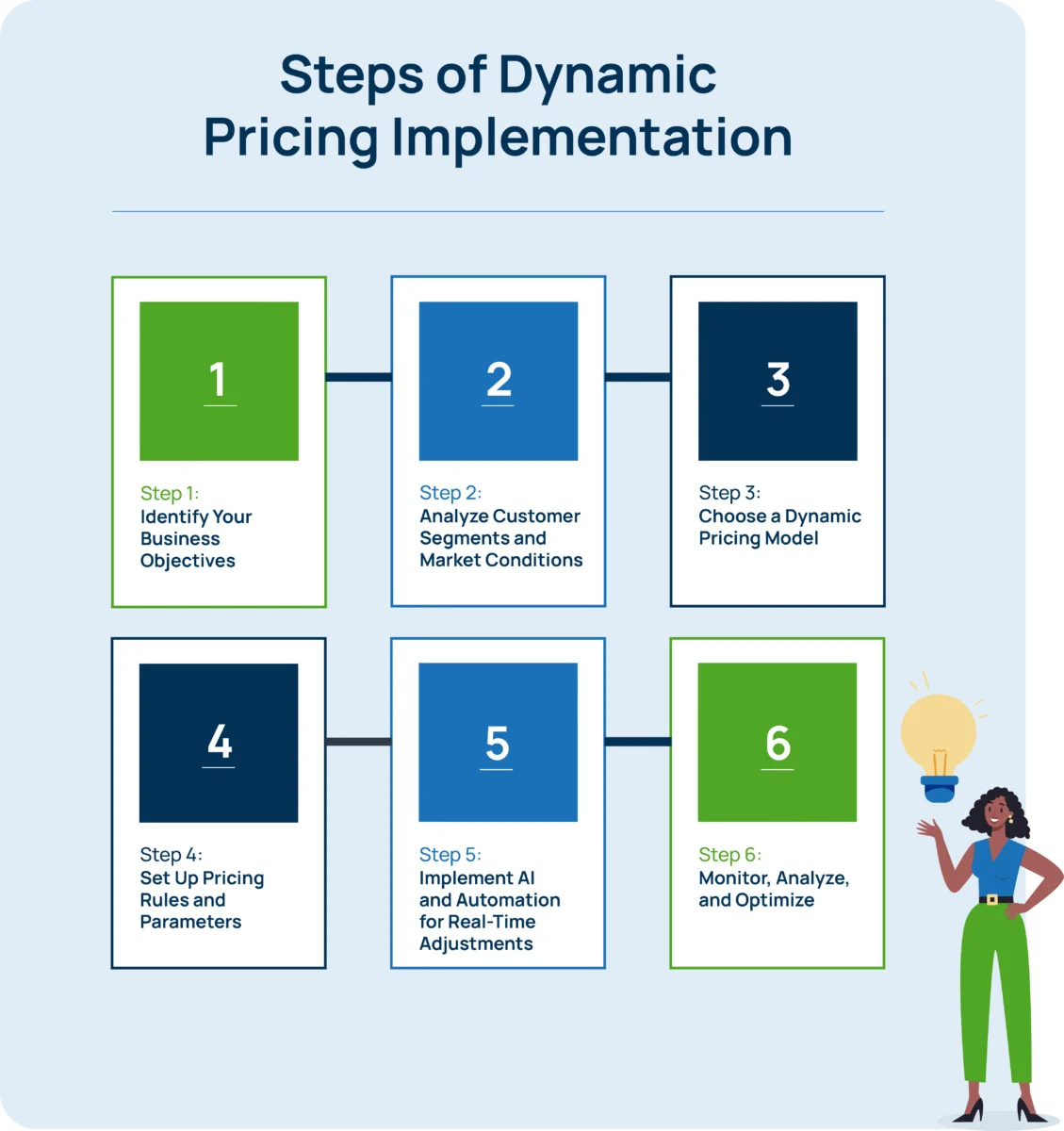What is Dynamic Pricing?
Dynamic pricing means that the price of a product will change according to changes in market demand and other criteria. Calculating the optimal price can be complex, but dynamic pricing software is available that can take into account numerous factors and make the calculation seamless. Prices can also be updated automatically, even second by second, to help companies keep up with changes in market conditions as they happen. With prices generated for the right customer at the right time and in the right market conditions, more sales are made and profits are increased.
Examples of Dynamic Pricing Strategies
Dynamic pricing strategies can be based on a range of criteria that affect the optimal price of a product. Examples of dynamic pricing strategies include:
Time-Based Dynamic Pricing
Shopping habits can change throughout the course of a day. For online stores, for example, peak demand tends to be between 9 am and 5 pm when people are in the office. Other businesses might find demand is at its highest on Saturday afternoons when more people are on the high street or hitting the mall. Adjusting prices in line with demand at that time of the day will help generate more sales and increase profits.
Segment-Based Dynamic Pricing
Segment-based pricing means offering the same product at different prices at any one time. Factors that decide how the different prices are determined include location and potential customers’ needs and income brackets. Another term for segment-based marketing is ‘price discrimination’
Market-Based Dynamic Pricing
Market-based pricing adjusts prices according to market conditions such as how much demand there is for a particular product at that time. A store that sells cold refreshments, for example, might raise its prices on a hot day because they know people are more likely to pay higher prices. Shortages of certain products are another example of when market-based pricing is employed.
Demand-Based Dynamic Pricing
Leverage real-time demand signals to adjust prices. Airbnb’s “Smart Pricing” automatically hikes rates during local events like music festivals, while airlines incrementally increase ticket costs as seats fill up. Demand-based dynamic pricing maximizes revenue during peak demand without alienating price-sensitive buyers. Event venues often use this approach, raising ticket prices as sold-out dates near while offering early-bird discounts to drive initial sales.
Competitor-Based Dynamic Pricing
Mirror or undercut rival pricing to retain market share. Amazon’s algorithm drops prices slightly if competitors like Walmart lower theirs, ensuring the “Buy Box” advantage. Gas stations often adjust fuel prices hourly based on nearby competitors to attract drivers. Online retailers use dynamic pricing optimization and analytics tools to track competitor pricing across regions, ensuring they never lose a sale due to being undercut.
Customer-Based Dynamic Pricing
Customer-based dynamic pricing tailors prices to individual behavior or loyalty tiers. SaaS platforms like Salesforce offer discounted annual plans for startups and premium enterprise tiers with priority support. Retailers like Target use purchase history to send personalized coupons, incentivizing repeat purchases.
Geographically-Based Dynamic Pricing
Adjust prices by region to reflect local costs or purchasing power. Microsoft charges less for Office 365 in some countries compared to others, while Uber sets lower per-mile rates in rural areas than in cities. Global manufacturers use this to account for tariffs or shipping costs. Tourism companies often price experiences higher in popular destinations while offering discounts in emerging markets to attract new visitors.
Execute straightforward, scalable price management across your organization.
What are the Benefits of Dynamic Pricing?
Dynamic pricing offers a variety of benefits to businesses implementing the model. Some of these benefits include:
- Maximizes revenue and profitability: Adjust prices during peak demand to capture higher margins (e.g., ride-sharing surge pricing) or stimulate sales in slower periods with strategic discounts. A hotel chain, for instance, might raise rates by 25% during popular conferences while offering midweek promotions to fill rooms.
- Enhances competitive advantage: With dynamic pricing software, businesses can react instantly to competitor price changes or inventory shifts. Retailers like Amazon adjust prices hourly to stay ahead. Manufacturers use AI dynamic pricing tools to undercut rivals during bidding wars without sacrificing margins.
- Optimizes pricing across customer segments: Tailor prices to specific groups, such as geographic regions, bulk buyers, or loyalty tiers. A SaaS company could offer startups discounted annual plans while charging enterprises premium rates for priority support.
- Increases customer satisfaction and retention: Personalized pricing (e.g., member-exclusive deals) and urgency-driven offers (e.g., “limited stock” alerts) make customers feel valued. A wholesaler might reward repeat buyers and foster long-term loyalty with volume-based discounts.
- Create demand: When demand is low, relatively few products will be sold. Dynamic pricing, however, enables companies to spark demand, helping them to generate more revenue from their products.
- Maximizes inventory management: Swiftly clear overstock with automated markdowns or hike prices for scarce items. For instance, airlines ensure flights are at capacity and minimize wasted inventory by dynamically pricing airfare as departure dates near.
- Drives real-time pricing adjustments: AI-powered tools analyze weather, social trends, or supply chain disruptions to recommend adjustments. For example, a beverage company raises prices during heatwaves as demand spikes.
- Improves price optimization: Leverage historical sales data and machine learning to identify ideal price points. A retailer might test $49 vs. $55 for a product, then adopt the price that maximizes both sales volume and profit.
- Reduces price sensitivity: Frame prices around outcomes (e.g., “saves 10 hours monthly”) rather than cost. A B2B software vendor highlights productivity gains to justify premiums, shifting focus from upfront cost to long-term value.
- Enables data-driven decisions: Distill raw data into actionable insights. A manufacturer analyzes regional buying patterns to allocate limited-edition products to high-willingness-to-pay markets, avoiding revenue leakage.
Dynamic pricing isn’t just about fluctuating numbers—it’s about responsiveness. “Trends like AI-powered dynamic pricing, agile pricing models, and targeted talent development are reshaping how businesses approach pricing,” said Morgan Short, Director of Content & Web Strategy at Vendavo.
Dynamic Pricing Challenges
While dynamic pricing has some clear benefits, it is not without its challenges. Some of these challenges include:
Customer Satisfaction and Retention
Dynamic pricing runs the risk of alienating some customers if they are paying more for the same product than other people are. Alienation can reduce customer satisfaction and might even lead to some customers being lost to competitors.
Data Acquisition and Utility
Acquiring data that can be used to make decisions can be time-consuming and expensive. In some cases, not all of the information that’s acquired will be useful. It might also be the case that very large databases are needed for algorithms to be able to generate accurate pricing. Data might also be required spanning different seasons and other factors that determine the optimal price.
Data Accuracy and Errors
There’s also a risk of inaccurate data that can lead to errors in pricing. Mistakes in pricing can have a negative impact on sales and revenue in the short term, while it might also affect a brand’s reputation in the longer term.
Competition
Your competitors are also likely to be doing what they can to encourage people to buy their products instead of yours. When competitors are trying to out-price each other, it runs the risk of starting a price war with prices continually being forced down. The result can be very slim profit margins.
How to Implement and Optimize a Dynamic Pricing Strategy
Dynamic pricing turns market volatility into a competitive edge. By following these best practices and leveraging tools like Vendavo Pricepoint and Deal Price Optimizer, businesses can leverage strategies that adapt in real time to demand, competition, and customer behavior.

Step 1: Identify Your Business Objectives
Define how dynamic pricing aligns with broader goals:
- Revenue growth: Capture higher margins during peak demand.
- Market share: Undercut competitors in price-sensitive segments.
- Inventory optimization: Clear overstock without eroding brand value.
Vendavo’s Profit Analyzer helps quantify objectives and simulates how price changes impact margins and customer retention.
Step 2: Analyze Customer Segments and Market Conditions
Segment customers by purchasing patterns, industry, or price sensitivity. For example, a manufacturer might group clients into “high-volume wholesalers” and “niche retailers.” Simultaneously, analyze external factors like competitor pricing spikes or supply chain delays.
Vendavo Pricepoint aggregates CRM, ERP, and market data to identify high-value segments and competitive threats.
Step 3: Choose a Dynamic Pricing Model
Select a model that aligns with your goals:
- Demand-based: Adjust prices during seasonal peaks (e.g., HVAC systems in summer).
- Competitor-based: Automatically match or undercut rivals.
- Time-based: Offer midday discounts for off-peak services.
Global enterprises often use hybrid pricing models that blend competitor signals with inventory levels to maintain agility.
Step 4: Set Up Pricing Rules and Parameters
Define guardrails to maintain brand integrity:
- Price floors: Prevent unprofitable discounts.
- Flexibility ranges: Allow 10–15% adjustments during shortages.
- Approval workflows: Flag deviations for manager review.
With Vendavo Pricepoint’s intuitive dashboard, you can configure rules to ensure compliance across global teams, such as auto-approving 5% discounts for loyal clients but requiring sign-off for deeper cuts.
Step 5: Implement AI and Automation for Real-Time Adjustments
Deploy AI to analyze data streams (e.g., weather, social trends) and adjust prices autonomously. For instance, a distributor might raise prices for scarce components during factory outages.
AI engines, such as Vendavo’s, process real-time data from numerous sources. These tools recommend optimal prices while balancing margin and volume, critical for industries like electronics manufacturing.
Step 6: Monitor, Analyze, and Optimize
Track KPIs like margin per segment, win/loss rates, and inventory turnover. A/B test pricing tiers (e.g., $99 vs. $109) to refine strategies. Vendavo’s analytics dashboards highlight underperforming SKUs, while Margin Bridge Analyzer pinpoints profit leaks.
Dynamic pricing isn’t a “set and forget” strategy. With Vendavo’s tools, businesses automate data collection, execute agile pricing, and turn insights into profit, without sacrificing customer trust.
At the end of the day, a dynamic pricing strategy will be easier to implement and more effective if you use software that’s designed for the task. The right software will be able to process the data you have with relative ease, and leverage the insights within to generate optimal pricing strategies.
For example, software such as Vendavo Pricepoint collates relevant pricing information from throughout a business into a single place. With Deal Price Optimizer, it’s possible to integrate directly with your Customer Relationship Management (CRM) platform and deliver optimal pricing intelligence using AI.
